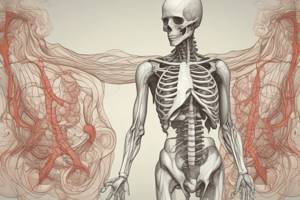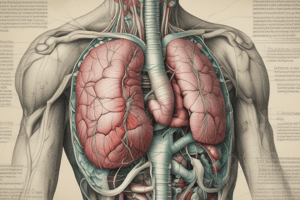Podcast
Questions and Answers
What are the two ways structures in the abdominal cavity can be classified?
What are the two ways structures in the abdominal cavity can be classified?
Retroperitoneal or intraperitoneal
What are the two types of retroperitoneal structures?
What are the two types of retroperitoneal structures?
Primary and secondary
Which structures fall under primary retroperitoneal?
Which structures fall under primary retroperitoneal?
- Kidney, suprarenal glands, aorta, inferior vena cava, rectum, and uterus (correct)
- Duodenum (2-4), pancreas, ascending colon, and descending colon
- Liver, stomach, gallbladder, duodenum, spleen, transverse colon, ileum/jejunum, cecum/appendix, and sigmoid colon
- None of the above
Which structures fall under secondary retroperitoneal?
Which structures fall under secondary retroperitoneal?
Which structures fall under intraperitoneal structures?
Which structures fall under intraperitoneal structures?
What are the three divisions of the peritoneal cavity?
What are the three divisions of the peritoneal cavity?
What are the five structures of the foregut?
What are the five structures of the foregut?
What are the four structures of the midgut?
What are the four structures of the midgut?
What are the three structures of the hindgut?
What are the three structures of the hindgut?
What are the three branches off of the celiac trunk?
What are the three branches off of the celiac trunk?
Which of these structures is supplied by the splenic artery?
Which of these structures is supplied by the splenic artery?
Which of these structures is supplied by the left gastric artery?
Which of these structures is supplied by the left gastric artery?
Which of these structures is supplied by the common hepatic artery?
Which of these structures is supplied by the common hepatic artery?
What is the portal triad?
What is the portal triad?
Where is the aortic hiatus located?
Where is the aortic hiatus located?
What is the opening via which the aorta, thoracic duct, and azygous vein pass through the diaphragm?
What is the opening via which the aorta, thoracic duct, and azygous vein pass through the diaphragm?
What is the name of the structure that connects the liver to the duodenum?
What is the name of the structure that connects the liver to the duodenum?
What is the name of the structure that connects the liver to the lesser curvature of the stomach?
What is the name of the structure that connects the liver to the lesser curvature of the stomach?
What is the name of the structure that separates the supracolic and infracolic regions of the greater sac and binds to the greater curvature of the stomach?
What is the name of the structure that separates the supracolic and infracolic regions of the greater sac and binds to the greater curvature of the stomach?
What is the name of the structure that divides the greater and lesser sac?
What is the name of the structure that divides the greater and lesser sac?
What is the function of the transverse mesocolon?
What is the function of the transverse mesocolon?
What is the name of the sac located deep to the lesser omentum that communicates with the greater sac via the omental foramen?
What is the name of the sac located deep to the lesser omentum that communicates with the greater sac via the omental foramen?
What is the primary function of the hepatic portal system?
What is the primary function of the hepatic portal system?
What structure collects blood from the GI tract and conducts it to the liver?
What structure collects blood from the GI tract and conducts it to the liver?
Where is the porta hepatis located?
Where is the porta hepatis located?
What is the function of the common bile duct?
What is the function of the common bile duct?
What are the viscera found in the upper right quadrant of the abdominal cavity?
What are the viscera found in the upper right quadrant of the abdominal cavity?
What viscera are found in the upper left quadrant of the abdominal cavity?
What viscera are found in the upper left quadrant of the abdominal cavity?
What viscera are found in the lower right quadrant of the abdominal cavity?
What viscera are found in the lower right quadrant of the abdominal cavity?
What is the main artery that supplies blood to the foregut?
What is the main artery that supplies blood to the foregut?
Flashcards
Classification of abdominal cavity structures
Classification of abdominal cavity structures
Structures can be classified as retroperitoneal or intraperitoneal.
Retroperitoneal structures
Retroperitoneal structures
Located behind the peritoneum.
Intraperitoneal structures
Intraperitoneal structures
Enveloped in visceral peritoneum and attached to the body wall via mesentery or ligaments.
Types of retroperitoneal structures
Types of retroperitoneal structures
Signup and view all the flashcards
Primary retroperitoneal
Primary retroperitoneal
Signup and view all the flashcards
Secondary retroperitoneal
Secondary retroperitoneal
Signup and view all the flashcards
Primary retroperitoneal structures
Primary retroperitoneal structures
Signup and view all the flashcards
Secondary retroperitoneal structures
Secondary retroperitoneal structures
Signup and view all the flashcards
Intraperitoneal structures
Intraperitoneal structures
Signup and view all the flashcards
Divisions of the peritoneal cavity
Divisions of the peritoneal cavity
Signup and view all the flashcards
Greater sac (supracolic)
Greater sac (supracolic)
Signup and view all the flashcards
Greater sac (infracolic)
Greater sac (infracolic)
Signup and view all the flashcards
Lesser omentum
Lesser omentum
Signup and view all the flashcards
Transverse mesocolon
Transverse mesocolon
Signup and view all the flashcards
Greater omentum
Greater omentum
Signup and view all the flashcards
Hepatoduodenal ligament
Hepatoduodenal ligament
Signup and view all the flashcards
Portal triad
Portal triad
Signup and view all the flashcards
Celiac trunk
Celiac trunk
Signup and view all the flashcards
Superior mesenteric artery
Superior mesenteric artery
Signup and view all the flashcards
Inferior mesenteric artery
Inferior mesenteric artery
Signup and view all the flashcards
Hepatic portal vein
Hepatic portal vein
Signup and view all the flashcards
Common bile duct
Common bile duct
Signup and view all the flashcards
Splenic vein
Splenic vein
Signup and view all the flashcards
Superior mesenteric vein
Superior mesenteric vein
Signup and view all the flashcards
Inferior mesenteric vein
Inferior mesenteric vein
Signup and view all the flashcards
Left gastric artery
Left gastric artery
Signup and view all the flashcards
Common hepatic artery
Common hepatic artery
Signup and view all the flashcards
Three sections of the GI tract
Three sections of the GI tract
Signup and view all the flashcards
Study Notes
Abdominal Cavity and Viscera Classification
- Structures in the abdominal cavity are classified as either retroperitoneal or intraperitoneal.
- Retroperitoneal structures are located behind the peritoneum.
- Intraperitoneal structures are enveloped in visceral peritoneum and attached to the body wall via mesentery or ligaments.
Retroperitoneal Structures
- Retroperitoneal structures are further divided into primary and secondary.
- Primary retroperitoneal structures develop and remain in the retroperitoneal space. Examples include the kidneys, suprarenal glands, aorta, inferior vena cava, rectum and uterus.
- Secondary retroperitoneal structures originate intraperitoneally but shift to a retroperitoneal position during development. Examples include portions of the duodenum, pancreas, ascending colon, and descending colon.
Intraperitoneal Structures
- Include the liver, stomach, gallbladder, duodenum, spleen, transverse colon, the small intestine (jejunum & ileum), cecum/appendix, and sigmoid colon.
Peritoneal Cavity Divisions
- The peritoneal cavity is divided into the lesser sac, supracolic greater sac, and infracolic greater sac.
Peritoneal Regions and Ligaments
- Lesser omentum: A double layer of peritoneum connecting the stomach and liver, creating a boundary between the greater and lesser sacs.
- Transverse mesocolon: The mesentery connecting the transverse colon.
- Greater omentum: A large apron-like structure attached to the greater curvature of the stomach and drapes over the intestines, separating the supracolic and infracolic regions of the greater sac.
- Lesser sac (omental bursa): Located behind the lesser omentum, communicating with the greater sac via the omental foramen.
- Hepatoduodenal ligament: Connects the liver to the duodenum.
- Hepatogastric ligament: Connects the liver to the lesser curvature of the stomach.
Abdominal Quadrants and Viscera
- Upper right quadrant: Liver, gallbladder, duodenum, pancreas, transverse and ascending colon, right kidney.
- Upper left quadrant: Stomach, spleen, left lobe of liver, part of pancreas, jejunum, transverse and descending colon, left kidney.
- Lower right quadrant: Ileum, cecum, appendix, ascending colon.
- Lower left quadrant: Ileum, descending colon, sigmoid colon.
Gastrointestinal Tract Divisions and Blood Supply
- The GI tract is divided into the foregut, midgut, and hindgut.
- Foregut: Esophagus, stomach, liver, spleen, gallbladder, duodenum (first half), and pancreas. Supplied by the celiac trunk.
- Midgut: Duodenum (second half), jejunum, ileum, ascending colon, and transverse colon (first two-thirds) - Supplied by superior mesenteric artery (SMA)
- Hindgut: Descending colon, sigmoid colon, and rectum - Supplied by inferior mesenteric artery (IMA)
Major Arteries and Veins
-
Celiac trunk: Major artery supplying the foregut
-
Superior mesenteric artery (SMA): Supplies the midgut
-
Inferior mesenteric artery (IMA): Supplies the hindgut
-
Aortic hiatus: Opening in the diaphragm allowing the aorta, thoracic duct, and azygous vein to pass into the abdomen.
-
Hepatic portal system: System of veins that carry blood from the digestive organs to the liver.
- Superior mesenteric vein: Drains the small intestines and ascending colon to the liver.
- Inferior mesenteric vein: Drains the large intestine to the liver.
- Splenic vein: Drains the spleen to the liver.
- Hepatic portal vein: Carries blood from the GI tract to the liver.
-
Portal triad (found at porta hepatis): Includes common hepatic artery, portal vein, and common bile duct.
-
Common bile duct: Carries bile from the liver and gallbladder to the duodenum.
Studying That Suits You
Use AI to generate personalized quizzes and flashcards to suit your learning preferences.
Description
This quiz covers the classification of structures in the abdominal cavity, distinguishing between retroperitoneal and intraperitoneal classifications. It details specific examples of primary and secondary retroperitoneal structures and lists various intraperitoneal structures. Test your knowledge on these anatomical concepts.




